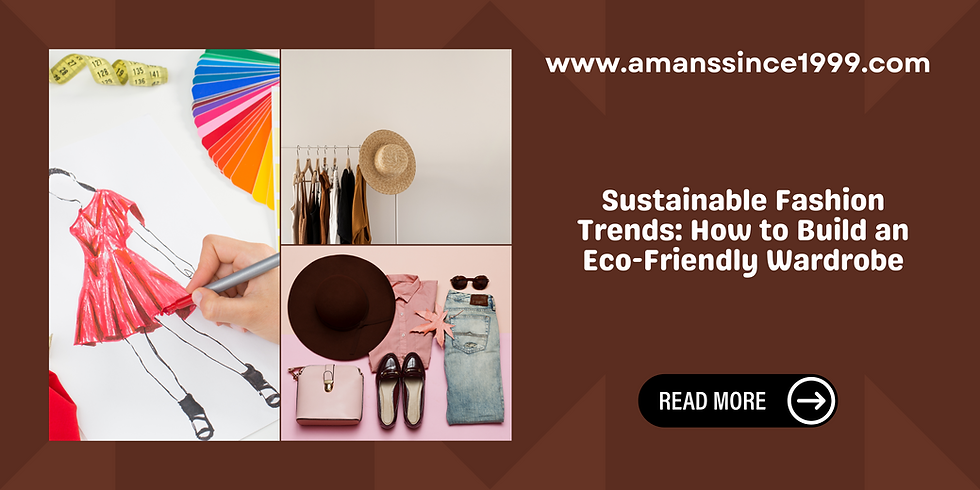Sustainable Fashion Trends: How to Build an Eco-Friendly Wardrobe
- janvi. dynasty
- Nov 13, 2024
- 3 min read

In recent years, sustainable fashion has become more than just a buzzword—it's a movement. With increased awareness of climate change and the environmental impacts of fast fashion, people are seeking ways to reduce their carbon footprint through more thoughtful clothing choices. Building an eco-friendly wardrobe is not only great for the planet but also helps support ethical labor practices and reduce waste. Here’s how to start building your own sustainable wardrobe, and which trends are shaping the world of eco-friendly fashion.
1. Opt for Quality Over Quantity
One of the foundational principles of a sustainable wardrobe is to buy less and choose well. Instead of impulsively buying trendy pieces that you might only wear a few times, invest in high-quality, timeless pieces that are versatile and built to last. By prioritizing quality over quantity, you'll reduce waste and ultimately save money by owning items that don’t need frequent replacements. Classic items like a well-tailored blazer, a cozy sweater, or a pair of high-quality jeans can be dressed up or down and remain stylish for years.
2. Choose Sustainable Fabrics
Not all fabrics are created equal when it comes to sustainability. Traditional materials like polyester, nylon, and even conventional cotton often have a large environmental footprint due to their production methods. Instead, look for eco-friendly fabrics like organic cotton, hemp, bamboo, and Tencel, which are derived from sustainable resources and tend to require fewer pesticides and less water. Another rising trend is recycled fabric, such as those made from repurposed polyester, which gives new life to plastic waste.
3. Support Ethical Brands
Many fashion brands are now adopting sustainable and ethical practices, from sourcing materials responsibly to ensuring fair wages for their workers. Research and support brands that are transparent about their production processes and are certified by organizations like Fair Trade, B Corp, or Global Organic Textile Standard (GOTS). Brands like Patagonia, Reformation, and Everlane have set the standard for transparency, showing consumers exactly where and how their clothing is made. When you support these brands, you’re not only getting stylish clothes but also contributing to better conditions for garment workers and more eco-friendly manufacturing practices.
4. Embrace Secondhand and Vintage Fashion
The concept of reusing and recycling doesn’t just apply to plastics and paper—it also extends to fashion. Shopping secondhand or vintage is a great way to find unique pieces and reduce demand for new clothing. Thrift stores, consignment shops, and online platforms like Poshmark and Depop make it easy to buy pre-loved clothing. Not only does this reduce waste, but it also gives you access to one-of-a-kind finds that add character to your wardrobe.
5. Rent Instead of Buy
Clothing rental services have gained popularity as people look to minimize their consumption. Companies like Rent the Runway and Nuuly offer options to rent high-quality clothing for special occasions or everyday wear. This is a great choice for items that you only need temporarily, such as formal attire or trendy pieces. Renting instead of buying reduces the demand for new production and helps keep fashion circular, as pieces are worn by multiple people instead of being discarded after a single use.
6. Take Good Care of Your Clothes
Sustainable fashion also means extending the lifespan of your clothes. Simple practices like washing your clothes in cold water, avoiding the dryer, and following care instructions can prevent wear and tear. When clothes inevitably become damaged, consider repairing them instead of discarding them. Sewing on a new button, patching a hole, or even getting creative with DIY alterations can give old clothes a new lease on life.
7. Mindful Decluttering
If you need to make space in your wardrobe, declutter mindfully by donating, selling, or recycling unwanted items rather than throwing them away. Many organizations, including Goodwill and Salvation Army, accept clothing donations, while other companies like H&M and Zara offer garment recycling programs. This way, your clothes avoid ending up in landfills and instead can be repurposed or recycled into new products.
Conclusion
Building a sustainable wardrobe is all about making intentional, eco-friendly choices that help reduce the environmental impact of fashion. By prioritizing quality, supporting ethical brands, and adopting practices like secondhand shopping and clothing rental, you can stay stylish while doing your part for the planet. Sustainable fashion isn’t just a trend—it’s a lifestyle choice that reflects your values and commitment to a greener future.




Comments